The vibration fiber optic perimeter alarm system market is expected to expand from USD 234.9 million in 2025 to USD 393.6 million by 2035, reflecting a CAGR of 5.3%. The market currently exhibits steady growth as adoption spreads across critical infrastructure, industrial facilities, transportation hubs, and high-security zones. Early adoption focuses on high-risk areas requiring advanced intrusion detection, with prioritize on real-time monitoring, low false alarm rates, and integration with existing security frameworks. During the initial years, the market remains far from saturation, driven by the need for reliable perimeter security in defense installations, data centers, and commercial complexes.
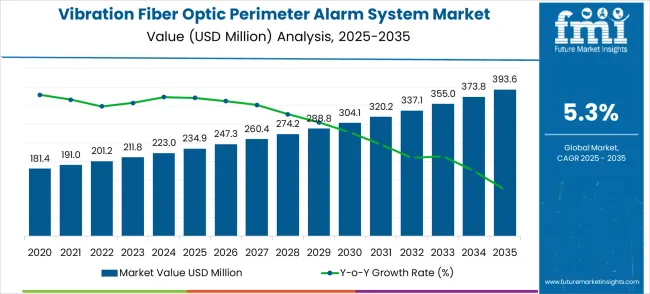
The saturation point is likely to approach in mature regions around 2032–2035, where nearly all high-priority facilities have implemented advanced fiber optic perimeter systems. At this stage, growth shifts from new installations to upgrades, system expansions, and integration with advanced analytics, AI-based monitoring, and IoT-enabled security platforms. Emerging regions, particularly in Asia Pacific and Latin America, continue to offer expansion potential as industrial and critical infrastructure projects rise. The market trajectory indicates a gradual approach to saturation, with early rapid adoption in high-security areas followed by steady growth driven by technological improvements, broader geographic coverage, and increasing system sophistication. Manufacturers can leverage this insight to focus on innovation, upgrade cycles, and regional penetration strategies to sustain revenue even as mature markets near full adoption. The vibration fiber optic perimeter alarm system market is segmented into critical infrastructure protection (38%), military and defense installations (27%), industrial facilities (16%), commercial properties (12%), and specialty applications such as airports and railways (7%). Critical infrastructure, including power plants, oil and gas facilities, and data centers, leads adoption due to the need for real-time intrusion detection and asset protection. Military and defense sectors rely on these systems for high-security perimeters. Industrial facilities use them to prevent theft and ensure operational safety, while commercial properties deploy them for enhanced building security.
Specialty applications include transportation hubs that require robust and reliable perimeter monitoring. Trends include integration with IoT-enabled monitoring, AI-based threat detection, and cloud analytics for real-time alerts. Manufacturers are innovating with long-range, low-maintenance, and environmentally resistant fiber optic cables. Expansion into smart city projects, critical infrastructure upgrades, and military deployments is driving adoption. Collaborations between system providers and security agencies support customized, scalable solutions. Focus on operational reliability, minimal false alarms, and seamless integration with existing security networks continues to fuel global market growth.
| Metric | Value |
|---|---|
| Market Value (2025) | USD 234.9 million |
| Market Forecast Value (2035) | USD 393.6 million |
| Forecast CAGR (2025–2035) | 5.3% |
Market expansion is being supported by the increasing sophistication of security threats across critical infrastructure and high-value facilities and the corresponding need for advanced perimeter detection systems that provide reliable intrusion detection with minimal false alarms and extensive coverage capabilities. Modern security applications require intelligent detection technologies that can differentiate between genuine threats and environmental disturbances while providing precise location information and real-time alert capabilities across extended perimeters. The superior detection range and environmental immunity characteristics of vibration fiber optic systems make them essential components in comprehensive security installations where accurate threat detection and operational reliability are critical for facility protection.
The growing focus on critical infrastructure protection and homeland security is driving demand for advanced perimeter security technologies from certified manufacturers with proven track records of reliability and performance in challenging environments. Government agencies and private sector operators are increasingly investing in fiber optic perimeter systems that offer comprehensive detection capabilities while enabling integration with existing security management platforms and automated response protocols. Regulatory requirements and security standards are establishing performance benchmarks that favor advanced fiber optic sensing solutions with intelligent analytics and proven effectiveness in diverse operational environments.
The market is segmented by system type, application, and region. By system type, the market is divided into buried type, fence type, and overhead type configurations. Based on application, the market is categorized into airports, military bases, oil and gas pipelines, prisons, data centers, and residential or community segments. Regionally, the market is divided into North America, Europe, East Asia, South Asia & Pacific, Latin America, and Middle East & Africa.
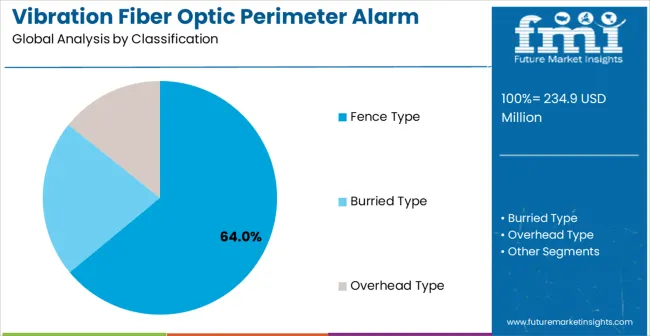
Fence Type configurations are projected to account for 64% of the vibration fiber optic perimeter alarm system market in 2025. This leading share is supported by the excellent balance of installation flexibility, detection accuracy, and cost-effectiveness that fence-mounted fiber optic systems offer for diverse perimeter security applications. Fence type systems provide comprehensive intrusion detection along existing perimeter barriers while maintaining visual deterrent value, making them the preferred choice for military installations, airports, industrial facilities, and high-security compounds. The segment benefits from technological advancements that have improved detection algorithms, reduced false alarm rates, and enhanced environmental adaptation capabilities.
Modern fence type vibration fiber optic systems incorporate advanced signal processing algorithms, intelligent pattern recognition technologies, and sophisticated environmental compensation systems that deliver exceptional detection accuracy while minimizing nuisance alarms from weather conditions, wildlife, and vegetation movement. These innovations have significantly improved system reliability while maintaining compatibility with various fence types and security integration platforms, reducing total cost of ownership through simplified installation and reduced maintenance requirements. The military and defense sector particularly drives demand for fence type solutions, as defense facilities require reliable perimeter security systems that can operate effectively in diverse environmental conditions while providing precise threat location information.
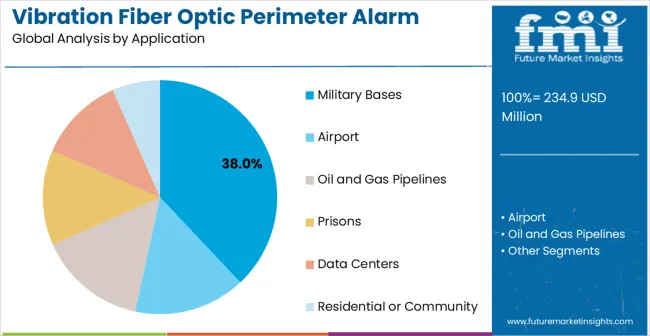
Military Bases applications are expected to represent 38% of vibration fiber optic perimeter alarm system demand in 2025. This dominant share reflects the critical importance of perimeter security in military facility protection and the need for advanced detection systems capable of providing reliable threat detection across extensive perimeters with varying terrain and environmental conditions. Military organizations require sophisticated and proven security systems for forward operating bases, strategic installations, weapons storage facilities, and command centers requiring maximum security assurance. The segment benefits from ongoing defense modernization programs and increasing military focus on force protection and installation security enhancement.
Military base applications demand exceptional detection performance to ensure reliable intrusion detection, accurate threat classification, and immediate alert capabilities that support rapid security response and threat neutralization across diverse operational environments and threat scenarios. These applications require perimeter systems capable of handling extreme environmental conditions, electromagnetic interference, and sophisticated intrusion attempts while maintaining continuous operation and integration with military command and control systems.
The vibration fiber optic perimeter alarm system market is advancing steadily due to increasing global security threats and growing recognition of advanced perimeter detection importance in critical infrastructure protection and facility security The market faces challenges including high initial system costs compared to traditional perimeter security solutions, need for specialized installation expertise and technical support, and varying environmental conditions affecting system performance optimization requirements. Standardization efforts and certification programs continue to influence system design quality and market development patterns.
The growing deployment of artificial intelligence algorithms and machine learning platforms is enabling sophisticated threat classification and automated false alarm reduction in fiber optic perimeter detection systems. AI-powered analytics and cloud-based processing systems provide continuous detection optimization while enabling predictive security assessment and automated threat response based on behavioral patterns and threat intelligence. These technologies are particularly valuable for large-scale installations and critical infrastructure facilities that require intelligent threat assessment and automated security response capabilities.
Modern perimeter security manufacturers are incorporating multi-sensor fusion technologies and comprehensive security ecosystem integration that enables simultaneous monitoring from fiber optic detection, video surveillance, thermal imaging, and radar systems while providing unified security management platforms. Integration of advanced sensor technologies and intelligent security analytics enables significant enhancement in overall security effectiveness and threat detection accuracy compared to single-sensor perimeter systems. Advanced data fusion and comprehensive threat assessment also support development of more responsive and effective security solutions for modern high-threat environments.
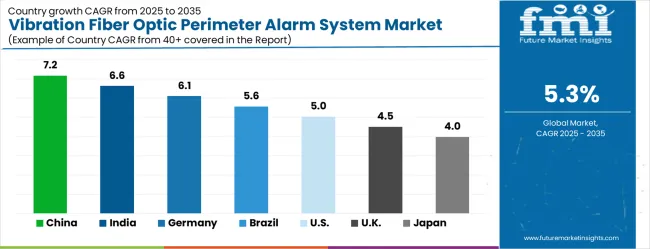
| Country | CAGR (2025–2035) |
|---|---|
| China | 7.2% |
| India | 6.6% |
| Germany | 6.1% |
| Brazil | 5.6% |
| United States | 5.0% |
| United Kingdom | 4.5% |
| Japan | 4.0% |
The vibration fiber optic perimeter alarm system market is growing steadily, with China leading at a 7.2% CAGR through 2035, driven by comprehensive infrastructure security initiatives, increasing government investment in border security technologies, and growing industrial facility protection requirements across strategic industries. India follows at 6.6%, supported by rising security infrastructure development, increasing defense modernization programs, and expanding critical infrastructure protection requirements across energy, transportation, and industrial sectors. Germany records strong growth at 6.1%, prioritizing precision security technologies, advanced industrial protection, and comprehensive infrastructure security supporting critical facility operations. Brazil grows steadily at 5.6%, integrating advanced perimeter security systems into expanding industrial infrastructure and growing security awareness across commercial and government facilities. The United States shows solid growth at 5.0%, focusing on defense facility protection, critical infrastructure security, and homeland security applications. The United Kingdom maintains steady expansion at 4.5%, supported by defense and security industry expertise and infrastructure protection requirements. Japan demonstrates consistent growth at 4.0%, prioritizing technological innovation and precision security applications.
The report covers an in-depth analysis of 40+ countries, Top-performing countries are highlighted below.
The vibration fiber optic perimeter alarm systems market in China is projected to exhibit the highest growth rate with a CAGR of 7.2% through 2035, driven by comprehensive infrastructure security programs and increasing government investment in advanced perimeter protection technologies across strategic facilities, border security, and industrial installations. The country's expanding critical infrastructure and growing security awareness are creating significant demand for sophisticated perimeter detection systems with fiber optic sensing capabilities. Major security system providers and government agencies are establishing comprehensive perimeter security installations to support large-scale infrastructure protection and meet evolving security requirements.
The vibration fiber optic perimeter alarm systems market in India is expanding at a CAGR of 6.6%, supported by rapid security infrastructure development and increasing defense modernization programs creating sustained demand for advanced perimeter protection technologies across military installations, critical infrastructure, and industrial facilities. The country's growing security awareness and expanding industrial sector are driving demand for perimeter security systems that provide reliable protection while supporting cost-effective deployment and operational efficiency. Security integrators and facility operators are investing in fiber optic detection technologies to support comprehensive facility protection and threat mitigation requirements.
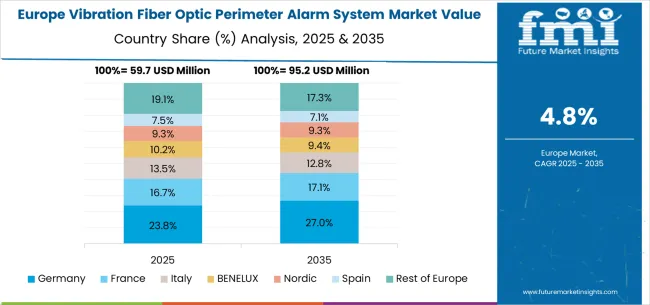
Demand for vibration fiber optic perimeter alarm systems in Germany is projected to grow at a CAGR of 6.1%, supported by the country's leadership in precision security technologies and comprehensive industrial protection requiring sophisticated perimeter detection capabilities for manufacturing facilities, energy infrastructure, and government installations. German security providers are implementing advanced fiber optic systems that support intelligent threat detection, comprehensive analytics, and seamless integration with existing security management platforms. The market is characterized by focus on technical excellence, system reliability, and compliance with stringent security and environmental standards.
Demand for vibration fiber optic perimeter alarm systems in Brazil is growing at a CAGR of 5.6%, driven by expanding industrial infrastructure and increasing security awareness creating opportunities for advanced perimeter protection technologies across energy facilities, manufacturing plants, and government installations. The country's growing economy and expanding security requirements are creating demand for perimeter systems that support comprehensive facility protection while maintaining operational cost effectiveness. Security providers and facility operators are adopting fiber optic detection solutions to support growing security demands and threat mitigation requirements.
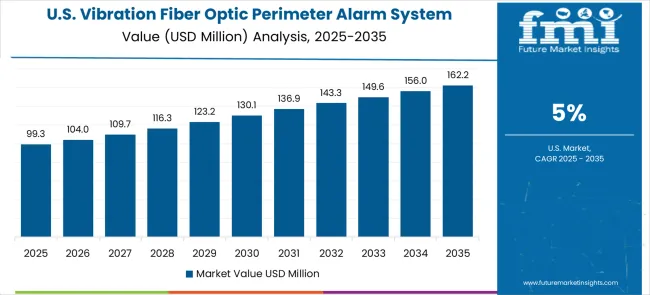
Demand for vibration fiber optic perimeter alarm systems in the United States is expanding at a CAGR of 5.0%, driven by comprehensive defense facility protection requirements and growing critical infrastructure security initiatives supporting homeland security, energy facility protection, and government installation security. The country's established defense industry and extensive critical infrastructure are creating sustained demand for advanced perimeter detection systems that provide reliable threat detection and integration with comprehensive security management platforms. Defense contractors and facility operators are implementing sophisticated fiber optic systems to support security optimization and threat mitigation requirements.
Demand for vibration fiber optic perimeter alarm systems in the United Kingdom is projected to grow at a CAGR of 4.5%, supported by defense and security industry expertise and comprehensive infrastructure protection requirements serving both domestic security needs and international security cooperation initiatives. The country's established security sector and growing prioritize on critical infrastructure protection are creating demand for advanced perimeter systems that support operational excellence while maintaining cost effectiveness. Security providers are maintaining comprehensive perimeter detection capabilities to support complex security requirements and international collaboration programs.
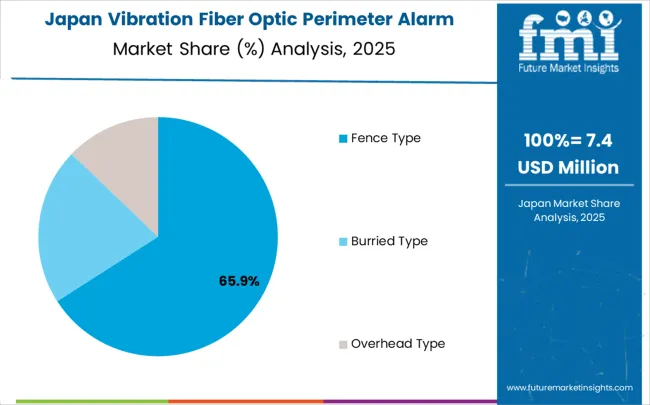
The vibration fiber optic perimeter alarm systems market in Japan is expanding at a CAGR of 4.0%, driven by the countries prioritize on technological innovation and precision security requiring advanced detection capabilities supporting critical infrastructure protection, industrial facility security, and comprehensive security system integration. Japanese security providers are developing sophisticated fiber optic technologies that incorporate advanced signal processing, intelligent analytics, and comprehensive system integration capabilities. The market benefits from focus on technological advancement, system reliability, and continuous improvement in security system performance.
The vibration fiber optic perimeter alarm system market is defined by competition among established security technology companies, specialized fiber optic sensing providers, and emerging intelligent security solution firms. Companies are investing in advanced detection algorithms, artificial intelligence integration, comprehensive system platforms, and global service capabilities to deliver reliable, accurate, and cost-effective perimeter security solutions. Strategic partnerships, technological advancement, and geographic expansion are central to strengthening product portfolios and market presence.
Senstar, operating globally, offers comprehensive perimeter security solutions with focus on fiber optic detection technologies, intelligent analytics, and technical support excellence. CAS REACHONE, specialized security technology company, provides advanced perimeter detection systems with prioritize on fiber optic sensing and system integration capabilities. Alptec delivers specialized security solutions with focus on perimeter protection and comprehensive security management. Optellios offers advanced fiber optic sensing technologies with focus on industrial and critical infrastructure applications.
Optex provides comprehensive security detection systems with focus on perimeter protection and intelligent analytics. FetnLaser delivers specialized fiber optic technologies with focus on high-performance detection applications. Alean offers comprehensive security solutions with focus on system integration and technical support. Lanstar provides specialized perimeter security systems with focus on fiber optic detection and operational reliability.
Dongguan Tuotian Intelligent Technology, FJINNO, Bandweaver, Huihong Fiber Technology, Future Fibre Technologies (FFT), Nippon Telegraph and Telephone (NTT), Southwest Microwave, OZ Optics, and Gavazzi Group offer specialized fiber optic expertise, regional manufacturing capabilities, and technical support across diverse security and industrial applications.
The vibration fiber optic perimeter alarm system market underpins critical infrastructure protection, national security enhancement, industrial facility security, and comprehensive threat detection advancement. With evolving security threats, increasing infrastructure vulnerability, and demand for intelligent detection systems, the sector must balance detection accuracy, operational reliability, and cost effectiveness. Coordinated contributions from governments, security agencies, technology providers, system integrators, and investors will accelerate the transition toward intelligent, connected, and highly effective perimeter security systems.
| Item | Value |
|---|---|
| Quantitative Units | USD 234.9 million |
| System Type | Buried Type, Fence Type, Overhead Type |
| Application | Airports, Military Bases, Oil and Gas Pipelines, Prisons, Data Centers, Residential or Community |
| Regions Covered | North America, Europe, East Asia, South Asia & Pacific, Latin America, Middle East & Africa |
| Country Covered | United States, Germany, India, China, United Kingdom, Japan, Brazil, and other 40+ countries |
| Key Companies Profiled | Senstar, CAS REACHONE, Alptec, Optellios, Optex, FetnLaser, Alean, Lanstar, Dongguan Tuotian Intelligent Technology, FJINNO, Bandweaver, Huihong Fiber Technology, Future Fibre Technologies (FFT), Nippon Telegraph and Telephone (NTT), Southwest Microwave, OZ Optics, Gavazzi Group |
| Additional Attributes | Dollar sales by system type and application, regional demand trends across North America, Europe, and Asia-Pacific, competitive landscape with established security technology providers and emerging fiber optic specialists, deployment preferences for buried versus fence versus overhead system configurations, integration with comprehensive security management platforms and automated response systems, innovations in fiber optic sensing technology and artificial intelligence for enhanced detection accuracy and false alarm reduction, and adoption of intelligent perimeter security systems with predictive analytics and automated threat assessment capabilities for improved security effectiveness and operational efficiency. |
The global vibration fiber optic perimeter alarm system market is estimated to be valued at USD 234.9 million in 2025.
The market size for the vibration fiber optic perimeter alarm system market is projected to reach USD 393.6 million by 2035.
The vibration fiber optic perimeter alarm system market is expected to grow at a 5.3% CAGR between 2025 and 2035.
The key product types in vibration fiber optic perimeter alarm system market are fence type, burried type and overhead type.
In terms of application, military bases segment to command 38.0% share in the vibration fiber optic perimeter alarm system market in 2025.






Our Research Products

The "Full Research Suite" delivers actionable market intel, deep dives on markets or technologies, so clients act faster, cut risk, and unlock growth.

The Leaderboard benchmarks and ranks top vendors, classifying them as Established Leaders, Leading Challengers, or Disruptors & Challengers.

Locates where complements amplify value and substitutes erode it, forecasting net impact by horizon

We deliver granular, decision-grade intel: market sizing, 5-year forecasts, pricing, adoption, usage, revenue, and operational KPIs—plus competitor tracking, regulation, and value chains—across 60 countries broadly.

Spot the shifts before they hit your P&L. We track inflection points, adoption curves, pricing moves, and ecosystem plays to show where demand is heading, why it is changing, and what to do next across high-growth markets and disruptive tech

Real-time reads of user behavior. We track shifting priorities, perceptions of today’s and next-gen services, and provider experience, then pace how fast tech moves from trial to adoption, blending buyer, consumer, and channel inputs with social signals (#WhySwitch, #UX).

Partner with our analyst team to build a custom report designed around your business priorities. From analysing market trends to assessing competitors or crafting bespoke datasets, we tailor insights to your needs.
Supplier Intelligence
Discovery & Profiling
Capacity & Footprint
Performance & Risk
Compliance & Governance
Commercial Readiness
Who Supplies Whom
Scorecards & Shortlists
Playbooks & Docs
Category Intelligence
Definition & Scope
Demand & Use Cases
Cost Drivers
Market Structure
Supply Chain Map
Trade & Policy
Operating Norms
Deliverables
Buyer Intelligence
Account Basics
Spend & Scope
Procurement Model
Vendor Requirements
Terms & Policies
Entry Strategy
Pain Points & Triggers
Outputs
Pricing Analysis
Benchmarks
Trends
Should-Cost
Indexation
Landed Cost
Commercial Terms
Deliverables
Brand Analysis
Positioning & Value Prop
Share & Presence
Customer Evidence
Go-to-Market
Digital & Reputation
Compliance & Trust
KPIs & Gaps
Outputs
Full Research Suite comprises of:
Market outlook & trends analysis
Interviews & case studies
Strategic recommendations
Vendor profiles & capabilities analysis
5-year forecasts
8 regions and 60+ country-level data splits
Market segment data splits
12 months of continuous data updates
DELIVERED AS:
PDF EXCEL ONLINE
Vibration Screening Machine Market Size and Share Forecast Outlook 2025 to 2035
Vibration Damping Levelling Feet Market Size and Share Forecast Outlook 2025 to 2035
Vibration Sensor Market Size and Share Forecast Outlook 2025 to 2035
Vibration Monitoring Market Size and Share Forecast Outlook 2025 to 2035
Vibration Analyzer Market Growth – Trends & Forecast 2025-2035
Vibration Level Switch Market Analysis by Technology, Industry, Application, and Region through 2035
Vibration Control Systems Market Growth - Trends & Forecast 2025 to 2035
Vibration Isolation System industry Analysis in India - Size, Share, and Forecast Outlook 2025 to 2035
Low Vibration Thermostat Market Size and Share Forecast Outlook 2025 to 2035
Anti-Vibration Mounts Market
Noise Vibration Harshness (NVH) Testing Market
Tower Vibration Control System Market Size and Share Forecast Outlook 2025 to 2035
Noise And Vibration Coatings Market Size and Share Forecast Outlook 2025 to 2035
Bonding Honeycomb Vibration Isolation Platform Market Size and Share Forecast Outlook 2025 to 2035
Fiberglass Centrifugal Fan Market Size and Share Forecast Outlook 2025 to 2035
Fiber to the Home Market Size and Share Forecast Outlook 2025 to 2035
Fiber Based Packaging Market Size and Share Forecast Outlook 2025 to 2035
Fiber Lid Market Forecast and Outlook 2025 to 2035
Fiberglass Tanks Market Size and Share Forecast Outlook 2025 to 2035
Fiber Sorter Market Size and Share Forecast Outlook 2025 to 2035

Thank you!
You will receive an email from our Business Development Manager. Please be sure to check your SPAM/JUNK folder too.
Chat With
MaRIA